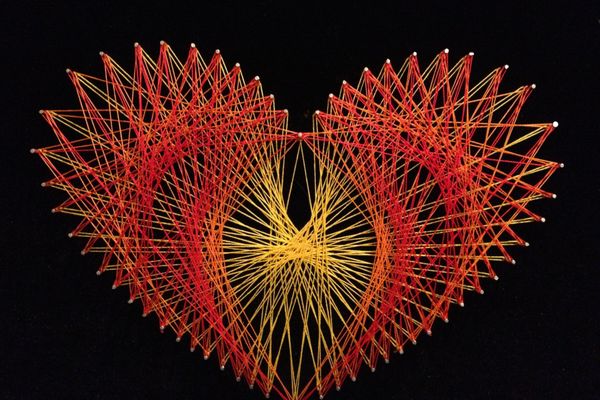Make string art
Make a colorful string art board with adult help by hammering nails into foam or wood, wrapping thread to form patterns and learning symmetry.



Step-by-step guide to make a colorful string art board
Paper Plate String Art Easy DIY Craft for Kids Full Length Tutorial
Step 1
Gather all your materials on a clear table so everything is ready to use.
Step 2
Fold a sheet of paper in half to prepare a template for a symmetrical design.
Step 3
Draw half of a simple shape along the folded edge of the paper.
Step 4
Cut along the line to make a full symmetrical paper template.
Step 5
Place the paper template where you want the design on the board.
Step 6
Trace around the template with a pencil to mark the outline on the board.
Step 7
Use a ruler to mark evenly spaced dots along the traced outline for nail placement.
Step 8
Have an adult hammer a nail into each marked dot leaving about half the nail sticking out.
Step 9
Tie the end of one color thread to a starting nail with a tight knot.
Step 10
Wrap the thread from nail to nail following the same pattern around the shape to build a symmetrical design.
Step 11
Tie off the end of the first color to a nail when you finish that layer.
Step 12
Tie a second color thread to a nail to start a new layer of string art.
Step 13
Wrap the second color around the nails to add more patterns and color.
Step 14
Tuck or tape any loose ends under nearby strings and put tools away with adult help.
Step 15
Share a photo of your finished colorful string art board on DIY.org.
Final steps
You're almost there! Complete all the steps, bring your creation to life, post it, and conquer the challenge!


Help!?
What can I use if I don't have a wooden board, nails, or embroidery thread?
Use thick corrugated cardboard or a foam board instead of a wooden board, pushpins or thumbtacks in a cork sheet as a substitute for nails and hammering, and use yarn or embroidery floss in place of thread.
My nails are bending or the thread keeps slipping—what should I do?
Have an adult pre-drill shallow pilot holes or use smaller finishing nails and make sure each nail is hammered leaving about half the nail sticking out so the thread can wrap securely without slipping.
How can I change the activity for different ages?
For toddlers and preschoolers have an adult fold and cut the paper template and pre-hammer the nails so they can focus on tying and wrapping thick yarn, while older kids can use a ruler to mark evenly spaced dots, create more complex templates, and add multiple color layers of thread themselves.
How can we personalize or make the string art more advanced?
Paint or stain the board before tracing the paper template, add beads as you wrap the second color thread for texture, experiment with denser wrapping patterns to create shading, and then tuck or tape any loose ends and share a photo on DIY.org.
Watch videos on how to make a colorful string art board
String Art for Kids
Facts about string art and woodworking for kids
🔨 A single string art board can use anywhere from a few dozen to several hundred nails or pins to create detailed patterns.
🛡️ Foam boards or push-pins are kid-friendly alternatives, while hammering nails into wood should always have adult help.
🎨 Layering different colored threads creates gradients and depth so you can make vibrant designs without paint.
🧵 String art began as "curve stitching" used by educators like Mary Everest Boole to teach kids about geometric shapes and curves.
🎯 When straight threads cross between nails they form smooth-looking curves called envelopes — a neat math trick you can see with yarn!
How do you make a colorful string art board with adult help?
What materials do I need for a kids' string art board?
What ages is string art suitable for and how much adult help is needed?
What are the benefits, safety tips, and fun variations for kids' string art?


One subscription, many ways to play and learn.
Only $6.99 after trial. No credit card required



